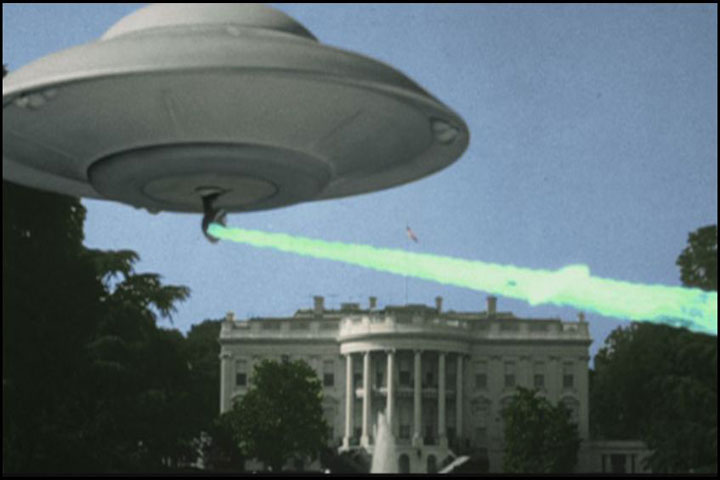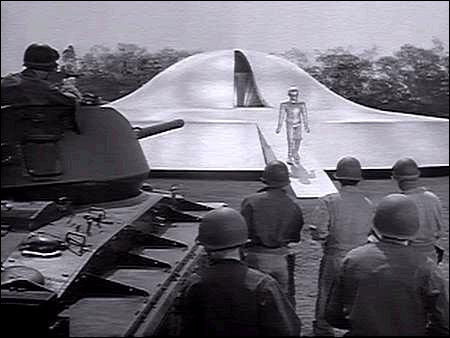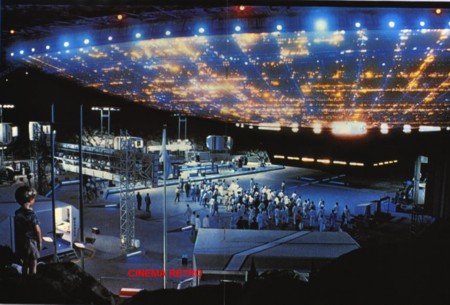
For decades popular culture has experienced and enjoyed two related phenomena, that of Unidentified Flying Objects (UFOs), along with alleged alien visitation, as well science fiction films that feature flying saucers and their occupants. Indeed, as author Paul Meehan has noted, “[s]aucer movies are a distinct subgenre of science fiction film, and perhaps should constitute a genre of their own.” Meehan has done fans of science fiction films involving UFOs, as well as those interested in the UFO phenomenon, a great service in writing Saucer Movies: A UFOlogical History of the Cinema (The Scarecrow Press, 1998). Paul has a B.A. in Cinema Studies from Hunter College in New York, where he studied with film writer Barbara Leaming. One of his classmates was Maitland McDonagh, author of Filmmaking on the Fringe and other books on the horror genre. In addition to Saucer Movies, he is the author of Tech-Noir: The Fusion of Science Fiction and Film Noir (2008), Cinema of the Psychic Realm: A Critical Survey (2009) and Horror Noir: The Nexus of Film Noir and the Horror Film, (to be published in 2010). He lives in San Francisco.
Paul and I explore the thesis of Saucer Movies in the following interview.
TheoFantastique: Paul, thanks for a great read in Saucer Movies. They have long been a favorite expression of science fiction for me going back to my childhood nightmares over Invaders from Mars. I’m glad to see someone explore this topic, and do so well. Your passion for the subject matter comes through in your writing. What is your personal connection to UFOs and their expression in cinema and television?
Paul Meehan: I was always a big fan of science fiction books, comics, TV and movies, and like everyone else I read the occasional news story about UFOs but was not overly concerned with them. Then in 1976 my wife saw a large, football-shaped object with extremely bright lights passing over the Jerome Park Reservoir in the Bronx in broad daylight. Although I did not see the UFO myself, I was mystified by her sighting and afterwards decided to explore the phenomenon in earnest. I discovered the “forbidden science” of ufology, an area of study with a rich and compelling literature that was very distinct from science fiction narratives. At some point I asked myself the question, “what if you analyzed sci-fi films in regard to their ufological content rather than as science fiction, and the idea for Saucer Movies was born. I looked at each of the 300 films in the book not only in terms of their critical and film historical significance, but also in terms of how they connect with the study of UFOs.
TheoFantastique: You remind your readers early on that science fiction has long had a connection to extraterrestrials. What are some of the earliest cinematic expressions of aliens, and to what do you attribute this early exploration of life on other worlds?
Paul Meehan: Cinema pioneer George Melies featured costumed “Selenite” moon-dwellers in A Trip to the Moon (1902), and in the British short When the Man in the Moon Seeks a Wife (1906) a moon man comes to earth looking for human females. Other silent film aliens appeared in A Trip to Mars (1910), A Message from Mars (1913), and Algol (1920). In the modern era, the Republic serial The Purple Monster Strikes (1945) provided the template for practically every Hollywood alien invasion film made during the 1950s. Prior to the arrival of flying saucers on the national scene in the summer of 1947, extraterrestrial themes were inspired by advances in aviation and rocket science, particularly in Germany, Russia and the United States during the 1920s and 30s that first popularized the idea of space travel. The works of Verne and Wells, and later the American pulp science fiction writers and cartoonists of the 30s and 40s, created a lively mythology of planetary voyages and extraterrestrial visitations. These themes did not find their true expression in movies, however, until after the UFO phenomenon first reared its ugly head during the “Roswell summer” of ‘47 and the Hollywood product began to be driven by what was being seen in the skies over America and reported on the front page of every newspaper in America.

TheoFantastique: You also describe the “relationship between UFOs and saucer movies” as “complex and multifaceted.” Before you examine this relationship chapter by chapter you describe various explanatory hypotheses to account for this relationship, including the Bad Film Hypothesis, the Government Conspiracy Hypothesis, and the Prescience Hypothesis. Can you briefly define these, and would you care to share which one you might subscribe to?
Paul Meehan: The Bad Film Hypothesis is the belief that the entire UFO phenomenon is an artifact of pop culture, derived specifically from obscure sci-fi dreck like Killers from Space, that presumably implant extraterrestrial notions inside the heads of UFO witnesses subconsciously. If this hypothesis was correct, then abduction reports should have emerged during the 1950s, when saucer movies were very popular, but abductions weren’t reported until the early 1960s. Abductees do not report meeting popular screen aliens that resemble E.T., Chewbacca, Yoda, Mr. Spock or the creatures from the Alien and Predator movies, but go on reporting the same bland little gray guys with monotonous regularity. The Government Conspiracy Hypothesis suggests that our government knows the truth about UFOs and is using the film business to disseminate info on covert U.S. contact with aliens. This theory is popular with many UFO proponents, but I have found absolutely no evidence to support this. The Prescience Hypothesis posits that film-makers are unconsciously tapping into the UFO reality and expressing this in movies in a precognitive fashion. One example of this is the flying saucer landing in Washington in 1951’s The Day the Earth Stood Still preceding the spectacular series of radar-visual sightings over D.C. in July of 1952. Another example is the Japanese monster movie Rodan (1956), which featured missing time amnesia and recovered memories associated with a mysterious flying object years before these themes became a standard feature of abduction reports. Since writing Saucer Movies, I have found more evidence of prescience manifesting itself in films on subjects other than UFOs, but that’s a topic for another book.
TheoFantastique: At several points in your book you note parallels between German folklore and UFOs and aliens. At least one folklorist, Bill Ellis, has made similar connections. Have these parallels been food for thought for you in the mix of UFO and alien sightings, and cinema perhaps all functioning as contemporary forms of folklore?
Paul Meehan: A connection between folklore themes and UFO lore was first explored in scientist Jacques Vallee’s 1969 book Passport to Magonia, in which he noted similarities between folk tales about elves, fairies, pixies, changelings and leprechauns and 20th Century accounts of UFO occupants. While there may be resemblances between the narratives (i.e. little people with magical powers, time dilation, stolen babies, etc.), many ufologists, myself included, do not find Vallee’s arguments persuasive. It’s undeniable that UFOs and aliens have a folkloric dimension in American culture, and those interested in this aspect of the phenomenon should consult Douglas Curran’s book In Advance of the Landing: Folk Concepts of Outer Space. In the 1990s, academic folklorist Thomas Bullard analyzed the content of nearly 200 alien abduction reports and concluded that the stories did not exhibit the standard characteristics of folklore narratives such as successive embellishment. I think that people often confuse the cultural manifestations of the UFO phenomenon with the phenomenon itself. We point to a ridiculous man in a tin foil hat rather than at a UFO that profoundly disturbs our worldview.
TheoFantastique: How has the cyclical nature of the popularity of UFO and alien movies related to UFO sightings? There doesn’t appear to be a direct correspondence in your research.
Paul Meehan: My research has found a negative correlation between historical UFO “waves,” or times of high UFO activity, and the release of important saucer movies. For instance, a significant UFO wave occurred in 1952, but the only alien-themed feature film released that year was the low-budget oddity Red Planet Mars, which didn’t even feature a spaceship. Similarly, 1973 was the year of the biggest UFO wave in history, but no saucer movies were produced by Hollywood in that year. Conversely, if movies produce UFO sightings, then 1953 would have been a peak year after the release of Jack Arnold’s classic 3-D saucer movie It Came from Outer Space and the first two alien invasion films in color, William Cameron Menzies’ Invaders from Mars and George Pal’s War of the Worlds, but this did not happen. Similarly, there was no upsurge in sightings after the release of Close Encounters in 1977 or Independence Day in 1996.
 TheoFantastique: I was intrigued by your comments on the “cinematic religious experience” that came with 2001: A Space Odyssey. You describe something similar with Close Encounters of the Third Kind, though not to the same extent in the film or in audience reactions. I had never noticed this element before in CETK, but I think you are correct. In what ways do you see CETK as expressing a type of religious or spiritual experience in connection with UFOs and aliens?
TheoFantastique: I was intrigued by your comments on the “cinematic religious experience” that came with 2001: A Space Odyssey. You describe something similar with Close Encounters of the Third Kind, though not to the same extent in the film or in audience reactions. I had never noticed this element before in CETK, but I think you are correct. In what ways do you see CETK as expressing a type of religious or spiritual experience in connection with UFOs and aliens?
Paul Meehan: Spielberg reportedly modeled CETK after 2001, watching Kubrick’s film numerous times during production. The vertical structure of Devil’s Tower was meant to suggest the similarly-shaped monolith in 2001. Both films center around a quasi-religious quest by a single individual (Keir Dullea in 2001, Richard Dreyfuss in CETK) to make contact with a godlike alien intelligence. The Moses-like Dreyfuss, climbs Devil’s Tower, a figurative Mt. Sinai, and later is taken up into the heavens in a celestial ship like the prophet Ezekiel. The entire film has a visionary quality that climaxes with the descent of the glittering mothership in the final reels. CETK‘s message of interplanetary peace, music and goodwill delivers a powerful spiritual message.
TheoFantastique: When you discuss UFO cinema and television in the 1970s I appreciated your mention of significant but neglected television efforts such as The Love War, The Enemy Within, and The UFO Incident, programs that resonated with my interest in UFOs as a teen. But then in the late 1970s UFO cinema exploded with films like CETK, Star Wars, and Alien. In this time period you say that the influence of conceptions of UFOs and aliens in cinema moved away from literature and toward the influence of UFO reports. Can you give a few examples?
Paul Meehan: Close Encounters led the way by incorporating material from various UFO reports into the plot, as detailed in my book, including the description of gray aliens. Even the film’s title is derived from the UFO typology developed by researcher Dr. J. Allen Hynek (who also appears briefly in the film). This trend actually started with the 1975 telefilm The UFO Incident, a docudrama based on the real-life UFO abduction of Betty and Barney Hill. After CETK, a number of films inspired by UFO events rather than fictional sources, including Starship Invasions (1977), Mysterious Two (1979), Hanger 18 (1980), Endangered Species (1982) and Wavelength (1983). Beginning in the late 1980s, films based on best-selling books about alien abductions, Communion (1989) and Intruders (1992) were produced, followed by the movie version of the Travis Walton abduction, Fire in the Sky (1993). TV’s The X-Files would later incorporate ufological material into the plotlines of the highly successful series..
TheoFantastique: You consider Contact a “lyrical film” that you rank alongside 2001 and CETK. What is it about this film that merits your praise in this context alongside these cinematic classics?
Paul Meehan: Contact is one of a very small number of alien-themed films (the short list includes 2001, Close Encounters, Cocoon, E.T., Starman and Phenomenon) in which extraterrestrials are friendly and provide something beneficial to mankind. It’s also a study of the Ellie Arroway (Jodie Foster) character, who is loosely based on real-life SETI scientist Jill Tartar. As such, the film has a distinctly feminine perspective that is very rare in science fiction cinema. The scene in which Ellie confronts the alien intelligence, disguised as a simulacrum of her dead father on a tropical beach with galaxies wheeling through the sky overhead is perhaps the most beautiful image in the history of the genre.
TheoFantastique: Given that your book was published in 1998 it ends with an analysis of UFO cinema as expressed from 1994-1997. If you were to update the book in order to account for developments in UFO cinema in the next decade, what type of observations would you make?
Paul Meehan: After the glory days of the saucer movie wave that lasted from 1994 to 1997, the whole subject became passé and science fiction film turned to cyberpunk and superhero themes. The few alien-themed movies that were made during this period were awful dreck like Evolution and Dreamcatcher, and after 9/11, aliens became equated with terrorists in films like the War of the Worlds remake and Cloverfield. The last few years, however, have seen a resurgence of the form in movies like Alien vs. Predator, The Day the Earth Stood Still retread, Monsters vs. Aliens and Race to Witch Mountain. This may be due to an uptick in dramatic UFO sightings reported in the media recently, including the Stephensville, Texas, Chicago-O’Hare and Tinley Park, Illinois sightings. I have been considering writing a sequel to Saucer Movies, which may be my next project.
TheoFantastique: Paul, thanks so much for your research into an interesting topic. I hope you’ll come back to discuss your other books and their subject matter.





For several years I have been searching for the title of a British, SciFi film I once saw on late night-night TV. It’s black & white, perhaps late 50s or early 60s? Basically, the plot centered around a spaceship that was discovered buried underground in a small English city. A dig-site is set up and team of investigators tries to figure out what it is, where it came from and decifer the strange glyphs written on the object. Eventually, the group triggers something on the craft and it morphs into this giant, towering eye, that sends out a destructive, searchlight beam. It was perhaps the strangest SciFi film I’ve seen. I know this is a long-shot, but if you can help, I’d appreciate it. Thanks.
I passed your question along to Paul Meehan and he sent the following response:
Re the writer’s query, I would say that the film is Five Million Years to Earth (1967), British title Quatermass and the Pit, one of scripter Nigel Kneale’s “Quatermass” series about English exobiologist Bernard Quatermass, here played by Andrew Kier. In the film,.workers digging a London subway discovered a Martian spaceship that has been buried for 5 million years and Quatermass and crew are called in to investigate. Using a diamond drill, the army manages to gain access to the ship’s interior, where they find the bodies of dead, locust-like aliens that are rapidly decomposing.
At some point an electrical worker zaps the ship with a high voltage cable, causing it to emit psychic waves that telepathically dominate some people and cause poltergeist-like energy disturbances throughout the city. The activation of some mechanism causes a towering “thought form” representing one of the Martians to materialize above the ship, appearing as a glowing mass of force crowned by a pair of satanic-looking horns. Scientist James Donald comandeers a giant crane and rams the metal mass into the apparition, shorting it out but electrocuting himself.
This sounds a lot like the film described. Although it’s in color, its possible it was seen on a black and white TV set. Hope this has been helpful.
Holy cow, that’s it! Thank you so much! Now, I just have to go find it. You are the man!
I’d like to thank Theofantastique for posting the interview with Paul Meehan. I stumbled upon this website by Googling “UFO myth blog.” I accidently came across it. I read Paul Meehan’s work at the NY Public Library. It was a fantastic read. I took plenty of notes and incorporated it into my own book, “How Modern Society Invented UFOs.” I am an admirer of Mr. Meehen’s work. I often wonder why his work doesn’t pop up among skeptics or folklorists. There have been a few who tied the film industry with UFOs, but none come close to Paul meehan’s book. Thanks again.